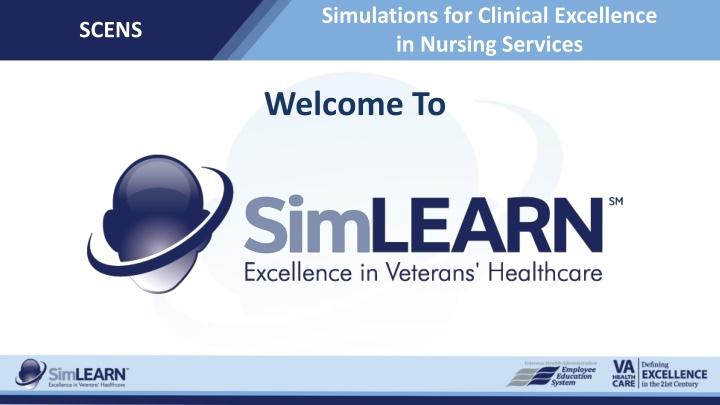Enhancing Nursing Services with SCENS Simulations for Clinical Excellence
SCENS (Simulations for Clinical Excellence in Nursing Services) offers a comprehensive training program focusing on initiating and monitoring Heparin infusion therapy while emphasizing effective communication. It aims to improve patient safety and quality of care by following evidence-based practices and best practice recommendations. The program covers Heparin indications, risks, and complications, along with detailed guidelines for therapy initiation, monitoring, and management of complications. SCENS utilizes computerized systems to reduce medication errors, increase accuracy, and standardize care delivery. Overall, SCENS is designed to enhance nursing competencies and promote excellence in clinical care.
Download Presentation

Please find below an Image/Link to download the presentation.
The content on the website is provided AS IS for your information and personal use only. It may not be sold, licensed, or shared on other websites without obtaining consent from the author.If you encounter any issues during the download, it is possible that the publisher has removed the file from their server.
You are allowed to download the files provided on this website for personal or commercial use, subject to the condition that they are used lawfully. All files are the property of their respective owners.
The content on the website is provided AS IS for your information and personal use only. It may not be sold, licensed, or shared on other websites without obtaining consent from the author.
E N D
Presentation Transcript
Simulations for Clinical Excellence in Nursing Services SCENS Welcome To
Learning Objectives SCENS 1. Initiate Heparin infusion therapy according to protocol 2. Monitor Heparin infusion therapy according to protocol 3. Demonstrate effective communication when caring for the patient receiving Heparin infusion therapy
Why? SCENS VHA National patient safety improvement handbook VHA Directive 1033: Anticoagulation therapy management VHA Directive 1014: Safe medication injection practices Institute for Safe Medication Practices List of High-Alert medications in Acute Care Settings Joint Commission National Patient Safety Goals
Evidence SCENS Computerized system to decrease med errors Improved accuracy Decreased med errors Increase in quality Standardization of care Multidisciplinary team focus
Heparin SCENS Indications Acute coronary symptoms** Deep vein thrombosis Pulmonary embolism Prosthetic valves Atrial Fibrillation/Flutter Other as indicated by provider Risks/Complications Thrombocytopenia Bleeding Death Does not dissolve existing thrombi/clots The patient must be in the hospital
Best Practice Recommendations SCENS Baseline activated partial thromboplastin Test (aPTT) Before treatment aPTT, platelets, International Normalized Ratio (INR) Initial bolus (Per protocol) Infusion rate(Per protocol) In consultation with the provider Monitor platelets Therapeutic range Should be stopped for surgery or other invasive procedures (4-6 hours prior) Monitor for bleeding If bleeding occurs: STOP the infusion Resuscitate the patient Check aPTT Notify the provider
Coagulation Cascade Review SCENS Primary Pathway Final Common Pathway
SCENS Nurse-Driven Heparin Infusion Licensed healthcare provider initiates Nurse Driven protocol Heparin orders verified by pharmacy Nurse reviews and verifies the order Nurse verifies baseline aPTT and platelet level Nurse calculates initial bolus and infusion rate based on protocol using a standardized tool (signature/initials required) Second Nurse calculates initial bolus and infusion rate using a separate tool (signature/initials required) Nurse documents initial bolus and infusion rate and time of initiation into template Patient education about IV Heparin completed Nurse administers appropriate bolus and infusion aPTTs are drawn by nurse at scheduled times aPTTs are run STAT by lab personnel and results available within one (1) hour Nurse review aPTT result and makes adjustments per Heparin Infusion Protocol If result is critical, Nurse caring for patient is contacted by lab personnel, Nurse contacts healthcare provider using ISBAR format and makes adjustments per order Nurse completes critical lab documentation **(see handout)
Patient/Family Education SCENS Bruising Bleeding gums Blood in urine Bleeding with bowel movements Pale Shortness of breath Dizziness Headache Signs of a stroke Electric razor Blowing their nose Clipping fingernails
Priorities SCENS Monitor the patient closely Anticipate any potential needs Provide patient education Communication Therapeutic level Safety Infusion pump only Antidote Patient must be in the hospital Identify risk factors Allergies
Facility Specific SCENS Heparin protocol Equipment/Supplies State licensure Scope of practice Certifications Accountability Documentation
Potential Issues SCENS Delays in treatment Bleeding Allergies Thrombocytopenia Non-therapeutic despite increasing rate of infusion
Summary SCENS 1. Reviewed Heparin infusion therapy initiation according to facility specific protocol 2. Discussed monitoring Heparin infusion therapy according to protocol 3. Demonstrated effective communication when caring for the patient receiving Heparin infusion therapy
Infusion: Heparin SCENS Betsy Harrison Sixty-five (65) year-old female is directly admitted from the outpatient clinic for deep vein thrombosis and Heparin infusion. Patient is s/p right hip fracture with open reduction internal fixation (ORIF) three (3) weeks ago. She just returned from a ten (10) hour car trip. The time is 0700. Medications: Metoprolol 50mg one time daily Simvastatin 40mg in the evening Ibuprofen 400mg three times a day for pain Allergies: No known drug allergies (NKDA) Past Medical History: Hypertension, hyperlipidemia, osteoarthritis, right hip fracture d/t fall Past Surgical History: Appendectomy, S/P open reduction internal fixation (ORIF) of the right hip























